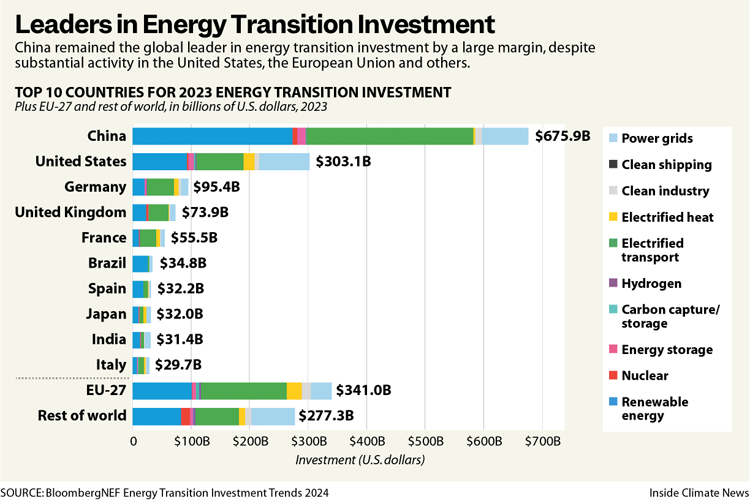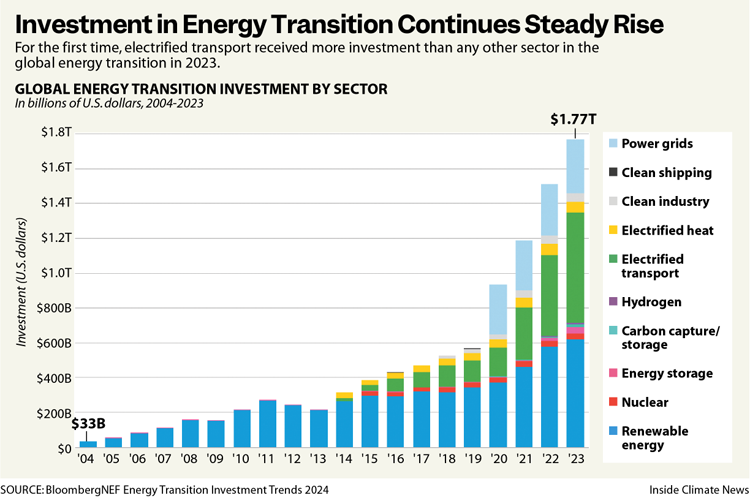Electrified Transport Investment Soared Globally in ’23, Passing Renewable Energy
Electrified transportation sped past renewable energy last year to become the world’s largest category of energy transition investment.
This finding, part of a report BloombergNEF released Tuesday, shows a shift that is “absolutely critical to getting to net zero,” said the lead author, Albert Cheung.
The transportation sector is a leading source of global carbon dioxide emissions, and, because of the long lives of vehicles, investment decisions today will take a while to translate into emissions reductions. Considering this, the rise in spending is necessary and will need to accelerate a lot more, said Cheung, deputy CEO at BloombergNEF.
We’re hiring!
Please take a look at the new openings in our newsroom.
See jobsGlobal investment in the energy transition totaled $1.77 trillion in 2023, an increase of 17 percent from the prior year, according to the report. Electrified transport spending was $634 billion, an increase of 36 percent.
The $634 billion total includes electric vehicles of all types, such as light cars and trucks, buses, commercial vehicles and two-wheelers, among others. It also includes money used to purchase the vehicles and spending to build factories and charging infrastructure.
The surge in global EV investment is happening at a time when some automakers are saying they overestimated demand for the vehicles in the United States. For example, Ford has said it will cut a shift at the Michigan plant that makes the Ford F-150 Lightning because sales have not kept pace with the rate of production.
Cheung said any concerns from automakers should be placed in the context that EV sales rose a lot last year, globally and in the United States.

Global renewable energy spending was $623 billion, up 8 percent from the prior year.
Looking at spending by country, China remained the world leader in overall energy transition investment with $676 billion, a decrease of 11 percent from the prior year.
The United States was second with an investment of $303 billion, up 22 percent from the prior year. The early implementation of the Inflation Reduction Act helped to drive growth, the report said.
While China continues to dominate, with more than one third of global investment, the combined total of the United States, European Union and United Kingdom was greater than China’s, which was different than in 2022.
“China just took the foot off the gas a little bit,” Cheung said.
A recurring theme across the clean energy economy is that investment is growing at a rapid rate, but that growth needs to happen faster.
Cheung said global spending on electrified transport alone would need to be an average of about triple the current level between now and 2030 to be on a path to net zero by mid-century. For perspective, that would mean the investment in this one category would need to be more than $1.8 billion, which was more than the sum of all categories in 2023.

Many people and organizations are trying to figure out how to make that happen.
“Considering only policies adopted to date, the road transport sector is not yet on a pathway compatible with limiting warming to 2 degrees Celsius,” said Joshua Miller, director of modeling, monitoring and evaluation for the International Council on Clean Transportation. He was referring to the level of temperature rise that scientists have said must be avoided to stave off catastrophic harm.
To accelerate the transition, he said, the world’s leading auto markets could take actions like phasing out sales of new internal combustion cars by 2035, and trucks and buses by 2040. Such a timeline would be necessary to get most internal combustion cars off the road by 2050. (Miller was co-author of a November analysis that looked at strategies that would be most effective for reducing transportation emissions.)
Some other notable findings from the BloombergNEF report:
- Global offshore wind spending was $76.7 billion, up 79 percent from the prior year. The pace of growth might be surprising, considering that the offshore wind industry had problems with canceled projects and other obstacles in the United States and in Europe. (Offshore wind spending is a subtotal within the analysis’ larger category of renewable energy.)
- Investment in hydrogen was $10.4 billion, roughly triple the prior year, and up from close to nothing five years ago.
- Spending on carbon capture nearly doubled. The leaders were the European Union with $5.7 billion, the United States with $2.8 billion and China with $926 million.
Share this article
Disclaimer: The copyright of this article belongs to the original author. Reposting this article is solely for the purpose of information dissemination and does not constitute any investment advice. If there is any infringement, please contact us immediately. We will make corrections or deletions as necessary. Thank you.







